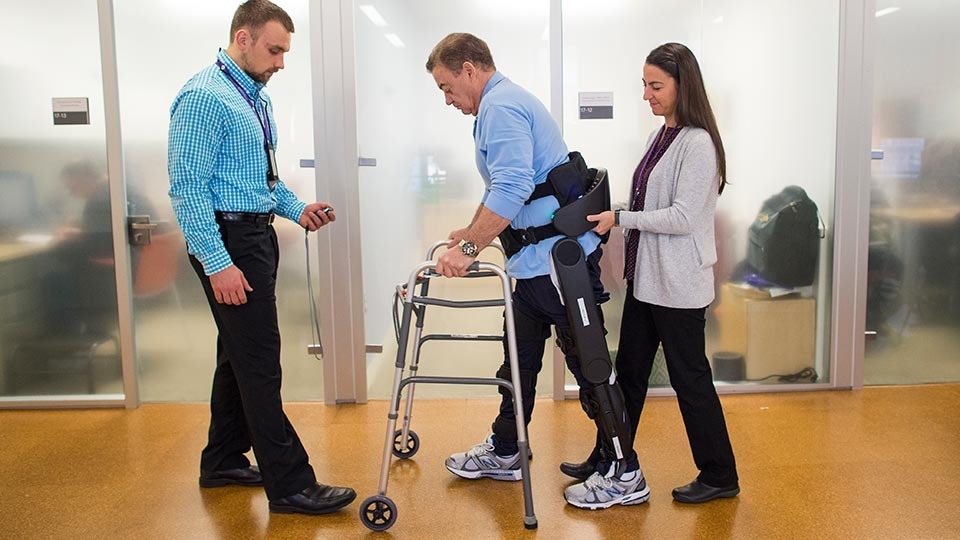
Physiotherapy
At Aliva Aesthetics, we are committed to helping you achieve optimal health and wellness. Our skilled team of licensed physiotherapists provides individualized care designed to meet your specific needs, supporting a faster recovery, improved mobility, and a pain-free lifestyle.
We recognize how essential it is to stay active and live without discomfort. Our goal is to equip you with the right tools, treatments, and education to support lasting health and well-being. With extensive training and experience, our physiotherapists offer a comprehensive range of therapies to treat a variety of physical conditions.
Consultation Process Includes :
Comprehensive Assessment & Evaluation
Customized Treatment Planning
Use of Advanced Techniques & Procedures
Ongoing Support & Regular Follow-Up
Chiropractor Treatment
Chiropractic adjustment, or spinal manipulation, involves applying controlled force to spinal joints using hands or specialized tools. Performed by trained professionals, this drug-free therapy aims to improve spinal mobility and overall body function. When safely conducted at home by a licensed practitioner, chiropractic care can help relieve conditions such as joint pain, back pain, and headaches. The primary goal is to restore joint function and muscle balance, which may also help reduce stress on the immune system. Chiropractors often recommend a combination of exercise, posture correction, massage, and nutritional advice to support at-home care, empowering patients to manage their symptoms and enhance quality of life.
Chiropractic care benefits anyone experiencing musculoskeletal discomfort, poor posture, or limited mobility. Since the spine plays a critical role in how the body functions, correcting misalignments can relieve pressure, improve function, and promote healing. Chiropractors also address sleep habits and mattress quality, recognizing their impact on spinal health. Patients seeking alternatives to surgery or pain medications often find relief through chiropractic care. Working collaboratively with other healthcare professionals, chiropractors provide holistic support. Along with pain relief, patients may experience improved sleep, breathing, and energy levels, making chiropractic treatment a valuable option for overall wellness and recovery.


Sports physiotherapy
Sports physiotherapy is a specialized branch of physical therapy focused on treating and preventing injuries related to sports and physical activity. It caters to both professional athletes and recreational players, offering tailored rehabilitation for muscle strains, ligament tears, joint issues, and other musculoskeletal disorders. The treatment involves a combination of hands-on therapy, stretching, strengthening exercises, and performance-enhancing strategies to ensure safe and efficient recovery. Sports injuries, if left untreated, can lead to long-term damage. Sports physiotherapy not only promotes healing but also helps prevent recurring injuries by improving strength, flexibility, and endurance. Common goals include pain relief, restored mobility, and enhanced physical performance. Key areas of focus include injury diagnosis, cause analysis, individual treatment planning, rehabilitation, and optimizing athletic performance. Anyone involved in physical activity can benefit from sports physiotherapy. It supports recovery from injuries as well as chronic conditions like spinal cord injuries or neurological disorders. Many centers also help improve cardiopulmonary endurance and breathing, enhancing overall athletic output. Recovery time varies depending on the severity of the injury, and physiotherapists guide patients through progressive exercises to regain full function. Customized programs ensure a safe, structured return to activity while reducing the risk of future injury.Pediatric physiotherapy
Pediatric physiotherapy focuses on improving the physical health and quality of life of infants, children, and adolescents. It is highly effective in managing perinatal conditions, early childhood diagnoses, and injuries sustained throughout a child’s development. With early intervention, pediatric physiotherapy can significantly reduce long-term disability, delay or eliminate the need for surgery, and ease the burden on future healthcare systems. Treatment is offered in various settings including hospitals, schools, and community centers. Pediatric physiotherapists work with children up to 18 years old, addressing neurological, developmental, orthopedic, and cardiorespiratory conditions. They aim to enhance motor control, muscle strength, pulmonary function, and physical endurance. Children with chronic conditions like cerebral palsy, cystic fibrosis, or juvenile idiopathic arthritis particularly benefit from physiotherapy interventions. Children who may benefit include those experiencing delays in achieving developmental milestones (like crawling or walking), using abnormal movement patterns (such as toe walking or bottom shuffling), or struggling with coordination and balance. Physiotherapists design personalized, play-based therapy programs to make sessions fun and engaging. They also assist children recovering from injuries or surgeries. By promoting independence and functional mobility, pediatric physiotherapy supports children in participating fully in daily activities such as playing, learning, and being part of a family and community.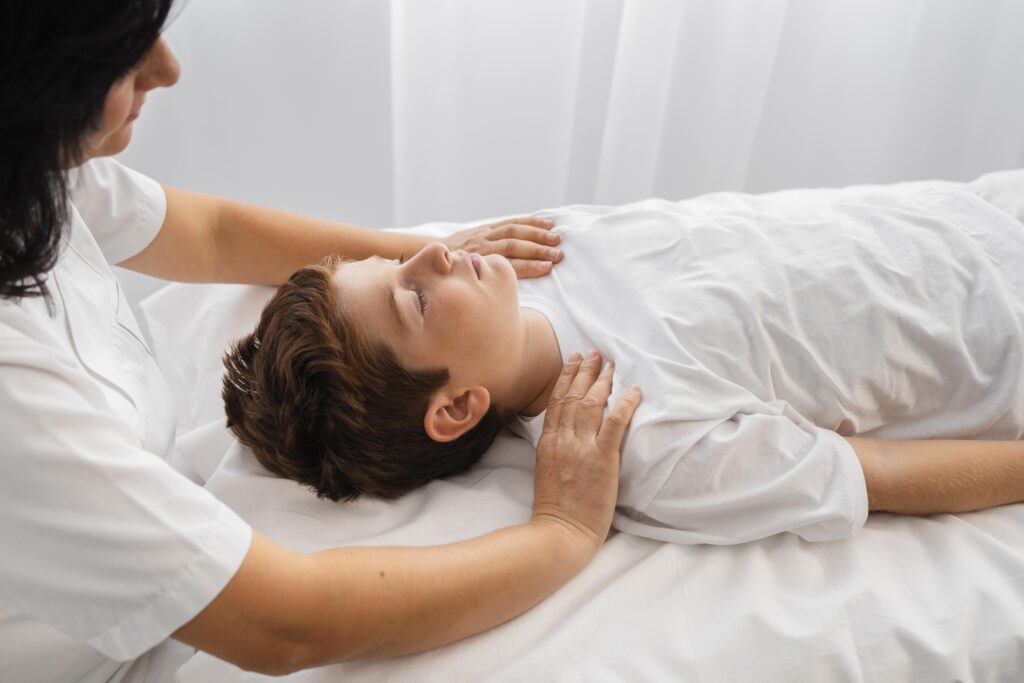
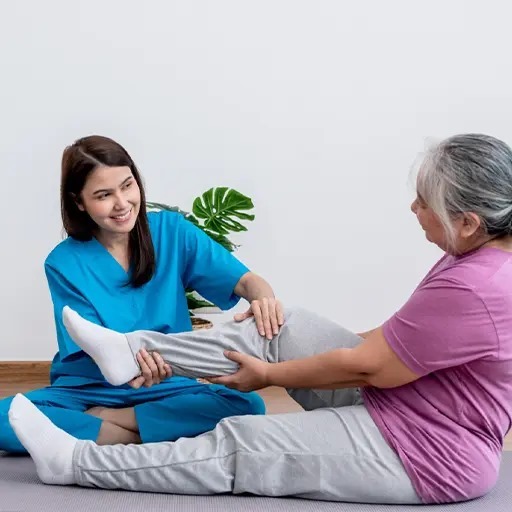
Home Physiotherapy
Home physiotherapy, also known as in-home physiotherapy, brings professional rehabilitation services directly to your home. It is especially beneficial for post-surgery recovery, elderly patients with mobility challenges, and individuals managing chronic conditions such as arthritis, Parkinson’s, or neurological disorders. It also supports those with orthopedic or musculoskeletal issues, providing comfort and convenience without the need to travel. Aliva Aesthetics Physiotherapy offers expert home physiotherapy services, delivering advanced care tailored to your specific health needs. Our trained physiotherapists begin with a detailed initial assessment at your home to understand your condition and physical limitations. A personalized treatment plan is then created based on clinical protocols and individual goals. Therapy sessions last between 45 minutes to an hour and are scheduled at your convenience. Progress is continuously monitored, focusing on pain relief, strength, flexibility, and improved daily function. For the best outcomes, ensure sessions take place in a clean, well-lit, and spacious area, wear comfortable clothing, and actively communicate with your therapist. Who can benefit :- Seniors with limited mobility
- Post-operative patients
- Individuals with balance or movement issues
- Busy professionals
- Children or neurological patients requiring long-term rehab
- Anyone seeking private, customized care in a home environment
Neurological physiotherapy
Neurological physiotherapy focuses on treating individuals with movement and functional disorders caused by damage to the nervous or neuromuscular systems. These disorders often lead to muscle weakness, poor coordination, tremors, spasticity, reduced sensation, and balance problems. Through targeted, repetitive exercises and therapeutic activities, neurological physiotherapy helps retrain the brain to form new neural pathways and improve motor function. This form of physiotherapy is highly personalized, involving patients in setting goals that are meaningful to their daily lives. Whether recovering from stroke, brain injury, multiple sclerosis, or spinal cord injury, patients can regain mobility and improve quality of life. Treatment aims to enhance strength, movement, coordination, and cardiovascular fitness while reducing pain and muscle tightness. Therapists also guide patients in modifying their homes and routines for safety and independence. Benefits include increased muscle strength through movement training, prolonged endurance via gait retraining, and improved balance to reduce fall risk. Mobility aids may also be introduced with proper instruction. Neurological physiotherapy empowers patients to optimize their current abilities and regain confidence in performing everyday activities. With consistency and guidance, many experience significant improvements in walking, hand function, and overall mobility, enabling a more active and independent life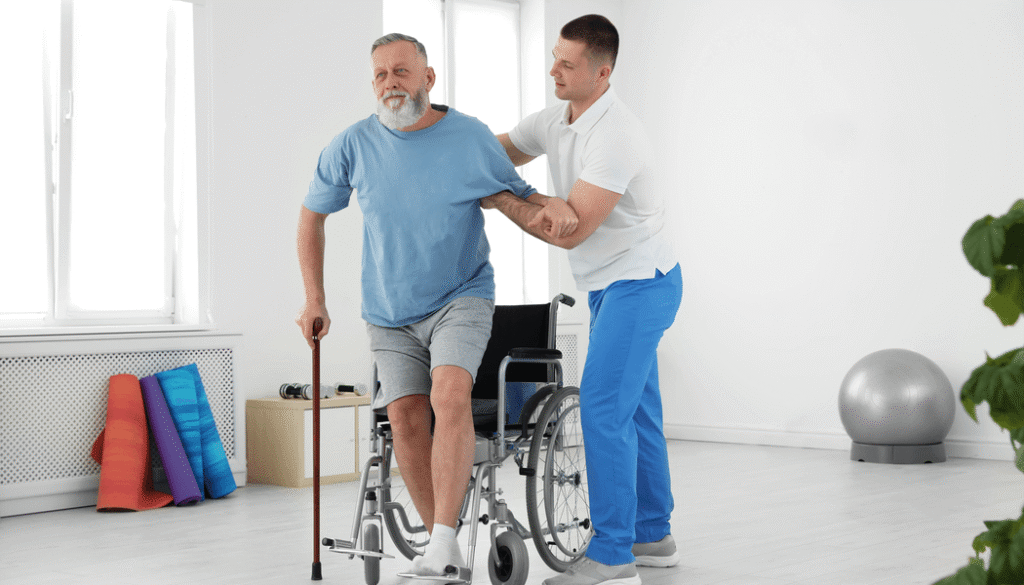

Pre-Surgery RehabilitationPre-surgery rehabilitation
Pre-surgery rehabilitation, or pre-rehab, is a personalized physical therapy program designed to prepare patients both physically and mentally for surgery. It focuses on reducing pain and inflammation, improving joint mobility, and enhancing muscle strength and flexibility. By training the muscles for post-operative exercises, pre-rehab helps ensure a smoother, faster recovery with fewer complications. It also boosts stamina and overall fitness, which can strengthen the immune system and reduce surgical risks. Patients who engage in pre-rehab often experience less anxiety and stress, leading to a more confident approach to surgery.
Benefits of Pre-Surgical Rehab :
Faster Recovery : Familiarity with exercises before surgery improves post-op results.
Fewer Complications : Stronger muscles and better fitness reduce surgical risks.
Reduced Anxiety : Physical preparedness enhances mental confidence.
Post-surgical rehabilitation is critical for safe and effective recovery. Once cleared by a doctor, a customized rehab plan is developed to help patients regain motion, strength, and function while managing pain and reducing swelling. Starting therapy early prevents stiffness and scar tissue buildup, enabling a quicker return to daily activities.
Benefits of Post-Surgical Rehab :
Improved Circulation : Techniques like massage and movement reduce clot risks and speed healing.
Pain and Swelling Reduction : Ice, ultrasound, and targeted exercises minimize discomfort.
Strength Recovery : Tailored programs help regain stamina and return to normal activities faster.
Pre and post-surgical rehabilitation are especially beneficial for orthopedic procedures. Whether it’s joint replacement, ligament repair, or spinal surgery, working with a physiotherapist before and after the procedure helps improve outcomes significantly. Treatments may include manual therapy, therapeutic exercises, and modalities like heat, cold, or electrical stimulation. Together, these rehab programs play a crucial role in a patient’s successful recovery journey.
Geriatric Physical Therapy
Geriatric physical therapy focuses on the unique needs of aging individuals, addressing a wide range of conditions such as arthritis, osteoporosis, cancer, Alzheimer’s disease, joint replacements, balance disorders, and incontinence. As people age, these conditions can significantly impact mobility, independence, and quality of life. Geriatric physiotherapists play a critical role in managing these challenges through tailored treatment plans that enhance physical function, relieve pain, and improve overall well-being. Geriatric physiotherapy typically addresses three main categories of problems. The first includes issues caused by inactivity or lack of exercise. These are managed through range-of-motion and strengthening exercises to improve flexibility and endurance. The second category involves cardiovascular conditions such as heart disease or stroke, where techniques like exercise, aquatic therapy, and electrical stimulation are used for recovery. The third category involves skeletal disorders, such as osteoporosis and osteoarthritis, which require careful, specialized treatment due to increased frailty and pain.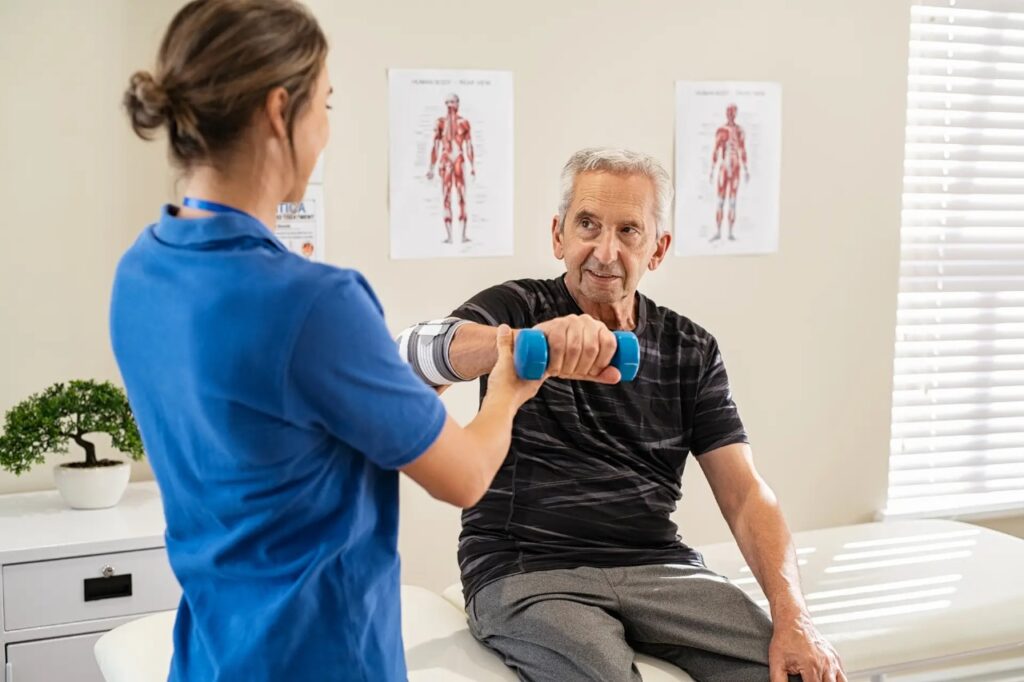
The goal of geriatric physiotherapy isn’t always to restore full health, but rather to help patients function at their best. This includes assisting with daily tasks, building balance and strength, and enabling participation in enjoyable activities like golf, which offers both physical and psychological benefits. With depression being common among the elderly, staying active is vital for mental health.
Additionally, geriatric physiotherapy supports recovery after surgeries such as knee or hip replacements, helping seniors adapt to new movement patterns and regain independence. Overall, it empowers older adults to lead healthier, more fulfilling lives
Strength Training
Strengthening refers to the muscle’s ability to generate tension, which helps stabilize and move the bones. Strengthening exercises aim to increase muscle strength, support overall health, and improve physical performance at any age. These exercises are essential for recovery, rehabilitation, and overall fitness. Whether for reconditioning after injury or for enhancing daily function, strength training plays a crucial role in physical well-being.
A strengthening program can benefit individuals with various conditions, including :
- Muscle weakness post-injury
- Pre- and post-surgical recovery
- Muscle atrophy after immobilization
- Movement dysfunction and poor posture
- Musculoskeletal issues like fractures, dislocations, or disc problems
- Neurological conditions such as stroke or Parkinson’s
- Geriatric conditions like arthritis and age-related muscle loss
- Pediatric delays in motor development
- Pre- and post-natal muscle weakness and incontinence
Anyone aiming to build or regain muscle strength can benefit from strengthening exercises. These exercises help rebuild lost muscle mass after injury or surgery, support growth in children with delayed milestones, and improve efficiency of movement. Stronger muscles reduce energy expenditure, improve balance, and lower the risk of falls and fractures—especially in the elderly. Strength training ultimately enhances functionality, independence, and quality of life

Advanced Physiotherapy
Advanced quality equipment and modern techniques are essential for delivering high-standard physiotherapy care. These innovations enable clinics to provide faster, more effective recovery solutions tailored to each patient’s unique condition. Unlike traditional methods, advanced physiotherapy integrates specialized machines and refined hands-on techniques to achieve optimal therapeutic outcomes. Advanced physiotherapy involves a range of specialized approaches aimed at managing pain, improving mobility, restoring function, and promoting healing. It often requires highly trained professionals who utilize state-of-the-art tools for precise diagnosis and targeted treatment. Techniques may include manual therapy, neuromuscular stimulation, laser therapy, ultrasound, and robotic-assisted rehabilitation. Benefits of Advanced Physiotherapy :- Reduction in pain and inflammation
- Improved mobility and flexibility
- Enhanced strength and endurance
- Accelerated healing and recovery
- Lower risk of reinjury or complications
Conditions Treated by Advanced Physiotherapy :
Chronic Pain : Conditions like back pain, neck pain, and fibromyalgia respond well to specialized pain management techniques.
Sports Injuries : Sprains, muscle tears, and ligament injuries benefit from customized rehabilitation protocols.
Post-Surgical Recovery : Techniques help restore function after joint replacements, ACL repairs, and more.
Neurological Disorders : Stroke, Parkinson’s disease, and multiple sclerosis can be managed with neuro-rehabilitation.
Cardiovascular Issues : Therapy supports heart disease and pulmonary rehabilitation through endurance and breathing exercises.
Arthritis : Pain and stiffness from osteoarthritis or rheumatoid arthritis are managed through joint-specific therapies.
Women’s Health : Pelvic floor therapy, incontinence, and pregnancy-related discomforts are treated effectively.
Geriatric Care : Age-related conditions like osteoporosis, balance issues, and fall risk are addressed through targeted exercises and stability training.
Advanced physiotherapy offers a comprehensive, science-backed path to recovery, improved functionality, and better quality of life.
Women’s Health Physiotherapy
Women’s Health Physiotherapy originated from the clinical areas of Obstetrics and Gynaecology and has expanded to address a broad range of women’s health issues. Initially focused on antenatal and postnatal care, incontinence treatment, and support following gynaecological surgeries, it now encompasses care for all age groups and stages of a woman’s life. This includes treatment for pelvic or vaginal pain, osteoporosis, lymphedema, post-breast surgery rehabilitation, musculoskeletal pain during pregnancy, and overall wellness through education and exercise.
Women across the lifespan—young athletes, expectant mothers, menopausal women, and the elderly—can benefit greatly from physiotherapy interventions. One of the most critical periods for physiotherapy is pregnancy. Prenatal, pregnancy, and postnatal physiotherapy help manage discomforts such as lower back pain, a common complaint among pregnant women. Through targeted stabilization exercises, physiotherapists support spinal health and improve sleep and mobility.

A vital aspect of women’s physiotherapy is Pelvic Floor Therapy, which focuses on strengthening the muscles that support the bladder, uterus, and bowel. This therapy is highly recommended before and after childbirth to prepare the body for labor, reduce potential damage, and restore pelvic muscle function. Postnatal pelvic floor rehabilitation can prevent or treat issues like urinary incontinence and chronic back pain.
Women’s health physiotherapy not only addresses specific conditions but also promotes long-term well-being. It enables women to remain active, reduces the risk of complications during and after pregnancy, and supports physical recovery after surgeries. Safe, personalized, and holistic, this form of physiotherapy empowers women to maintain strength, confidence, and control throughout every phase of life.
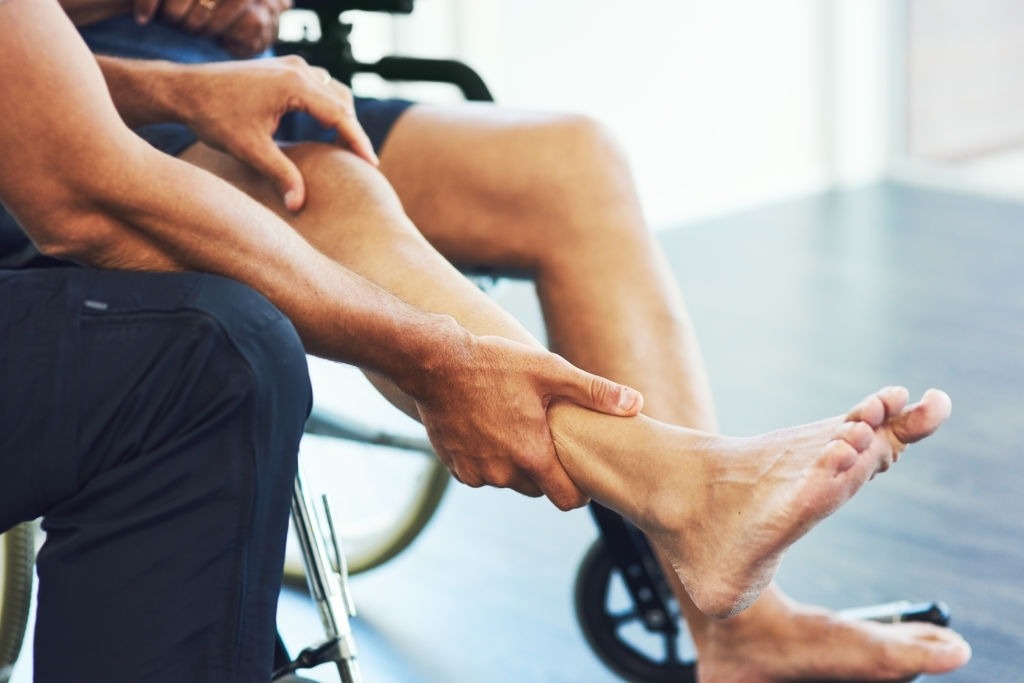
Musculoskeletal Physiotherapy
Musculoskeletal physiotherapy is a specialized branch of physical therapy focused on diagnosing, treating, and managing disorders that affect the muscles, joints, bones, and associated soft tissues. It is designed for patients experiencing symptoms of musculoskeletal disorders such as tendonitis, arthritis, carpal tunnel syndrome, back or neck pain, and postural dysfunction. The goal is to enhance recovery, reduce pain, and improve functional mobility, allowing individuals to regain independence and return to their daily activities. This type of physiotherapy targets issues that disrupt how the body moves—whether it’s the lower limbs, upper limbs, or spine. Injuries or chronic conditions that impact these areas can significantly reduce quality of life. Musculoskeletal physiotherapists are highly trained in advanced assessment techniques and tailor each treatment plan to the individual based on their condition and recovery goals.Treatment often includes :
- Manual Therapy and Manipulation – to restore joint movement and reduce stiffness
- Massage – for soft tissue relaxation and circulation
- Exercise Therapy – to improve strength, flexibility, and endurance
- Electrotherapy – such as TENS or ultrasound to reduce pain and inflammation
- Pain Management and Self-Management Strategies – empowering patients with coping tools
Benefits of musculoskeletal physiotherapy include :
- Improved strength, flexibility, and range of motion
- Enhanced coordination and control of movement
- Relief from acute or chronic pain
- Prevention of future injuries through education and proper movement training
- Support in achieving fitness and physical activity goals
Musculoskeletal physiotherapy not only speeds up recovery but also equips patients with the knowledge and strategies needed for long-term musculoskeletal health and a better quality of life
Vestibular Rehabilitation (vr)
Vestibular Rehabilitation Therapy (VRT) is a specialized, exercise-based therapy designed to reduce symptoms caused by vestibular disorders. These disorders can affect balance and spatial orientation, leading to dizziness, vertigo, gaze instability, nausea, and unsteadiness. While damage to the vestibular system is often permanent, VRT helps the brain compensate by relying more on vision and somatosensory input (body awareness).
The primary goals of VRT are to improve balance, reduce dizziness, and enhance daily function. At your initial evaluation, a physical therapist will assess balance, gait, strength, flexibility, eye movements, neck mobility, and conduct positional testing to identify the root of the symptoms. Based on this assessment, a personalized exercise program is developed to promote compensation.
Three key types of VRT exercises are commonly used :
Habituation Exercises – Reduce dizziness through repeated exposure to symptom-triggering movements.
Gaze Stabilization – Improve control of eye movements during head movement.
Balance Training – Enhance steadiness and coordination during standing and walking.
Conditions treated with VRT include :
- Benign Paroxysmal Positional Vertigo (BPPV)
- Chronic dizziness and vertigo
- Inner ear disorders
- Imbalance and frequent falls
- Vestibular migraines and post-concussion syndrome
For BPPV, simple repositioning maneuvers often resolve symptoms within a few sessions. For other vestibular disorders, patients may need several weeks of progressive exercises. When followed consistently, VRT significantly reduces or even eliminates symptoms, restoring confidence and improving quality of life. Vestibular rehabilitation empowers individuals to regain control over their balance and mobility, offering relief from what can often be debilitating and disorienting symptoms.
Workplace Ergonomics : Assessment & Training
Ergonomics is the study of how people interact with their working environment, focusing on both the physical and structural aspects of a workplace. The physical environment includes tools and equipment used by employees, while the workplace environment encompasses elements like lighting, temperature, flooring, and overall layout. The goal of ergonomics is to adapt the work environment to the needs and capabilities of the individual, rather than forcing workers to adjust to potentially harmful settings.
When ergonomics are poor, they can contribute to the development of musculoskeletal disorders (MSDs) and other health issues. Symptoms often begin subtly and may be mistaken for other conditions or overlooked entirely. Common health problems resulting from poor ergonomics include :
- Neck, back, shoulder, and arm pain
- Headaches
- Repetitive strain injuries (RSIs)
- Carpal tunnel syndrome
- Postural muscle aches
- Increased risks of diabetes, obesity, heart disease, and stroke due to sedentary behavior
An ergonomic assessment evaluates physical stress on muscles, bones, and joints to reduce injury risks. It also considers posture, movement, work behaviors, and the design and placement of equipment. Key aspects include how often an employee stands or moves, the positioning of computers and keyboards, and the comfort of the overall work environment.
Benefits of a detailed ergonomic assessment include :
- Promoting a healthier and safer workplace
- Enhancing employee productivity and comfort
- Lowering healthcare and compensation costs
- Preventing long-term injuries and postural issues
- Improving workplace morale and employer-employee relationships
Following the assessment, a formal report is provided with findings and recommendations. Employees are then trained to use proper posture and techniques tailored to their specific tasks and environment.
Ergonomic interventions are beneficial across various roles. For instance, an office worker may suffer from wrist and shoulder pain due to improper mouse and keyboard placement, while a factory worker might face neck or back injuries from poor lifting techniques. Ergonomic training programs can significantly reduce such risks and improve workplace efficiency and satisfaction
Therapeutic Massage
Therapeutic massage is a specialized treatment involving the application of pressure to the body to achieve corrective, rehabilitative, or healing effects. This pressure can be applied using the hands, fingers, elbows, forearms, knees, feet, or even mechanical aids. The goal is to facilitate energy flow, relieve pain, reduce muscle tension, and promote overall wellness.
Massage stimulates the circulatory and lymphatic systems, helping to deliver nutrients and oxygen to the body’s tissues while aiding in the removal of waste products and toxins. This enhanced circulation not only improves overall health but also accelerates healing and tissue regeneration.
Benefits of therapeutic massage include :
- Decreased pain and muscle soreness
- Improved range of motion and movement
- Relief from muscle tension and stiffness
- Enhanced blood and lymph flow
- Better physical functionality
- Stress reduction and deep relaxation
Massage can be adapted to target specific areas or address full-body discomfort. It involves stroking, kneading, tapping, or applying deep or gentle pressure, depending on the therapeutic goal.
Key principles of therapeutic massage include :
Depth of Pressure : The amount of force applied. It should be gradually increased with caution, especially if discomfort arises.
Speed of Stroke : Can be fast or slow, depending on the intended effect (relaxation vs. stimulation).
Rhythm : Consistent, steady movements enhance comfort and effectiveness.
Duration : Refers to how long each stroke is applied or how long the treatment lasts.
Direction : Strokes are typically directed toward the heart to support venous return and lymphatic drainage.
Frequency : Indicates how often a stroke is repeated in a session.
While massage offers numerous health benefits, it may not be suitable for everyone. Caution should be exercised in individuals with :
- Contagious diseases
- Vomiting or diarrhea
- High fever
- Severe or unexplained pain
- Kidney disease
- Thrombosis or clotting disorders
Therapeutic massage, when performed by trained professionals and guided by individual health needs, can be a powerful tool for healing, relaxation, and improved physical function
Tele-physiotherapy
Tele-physiotherapy, or virtual physiotherapy, is a modern healthcare service that utilizes telecommunications technology to deliver physiotherapy consultations, assessments, diagnoses, and treatment plans remotely. Through video calls, emails, and specialized apps, patients can receive high-quality physiotherapy care from the comfort of their homes. This service has made accessing physiotherapy easier than ever. All a patient needs is a smartphone or computer with a camera, microphone, and a stable internet connection. After booking an appointment, the physiotherapist conducts an online assessment by reviewing the patient’s medical history, symptoms, and physical condition. Based on this, a personalized treatment plan is developed, including exercise routines with specific sets and repetitions suitable for a home environment. Progress is monitored during follow-up sessions using video calls, allowing the physiotherapist to make necessary adjustments.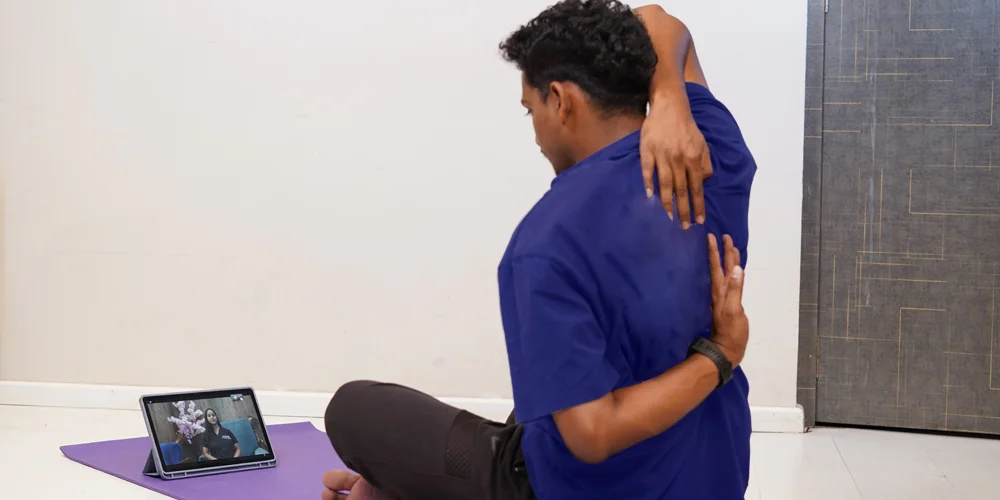
Who can benefit from Tele-physiotherapy?
- Patients too unwell to travel
- People living in remote or rural areas
- Caregivers responsible for children or elderly family members
- Individuals with transportation issues
- Those with tight schedules and limited time
Tele-physiotherapy offers many benefits. It enhances accessibility, reduces travel time and cost, and maintains continuity of care. It is particularly helpful during pandemics or for patients with mobility limitations. Moreover, it supports the healthcare system by reducing the burden on in-person services, while still providing effective and personalized care.
By making physiotherapy more flexible and accessible, tele-physiotherapy not only improves the quality of life for patients but also promotes better health outcomes across communities.
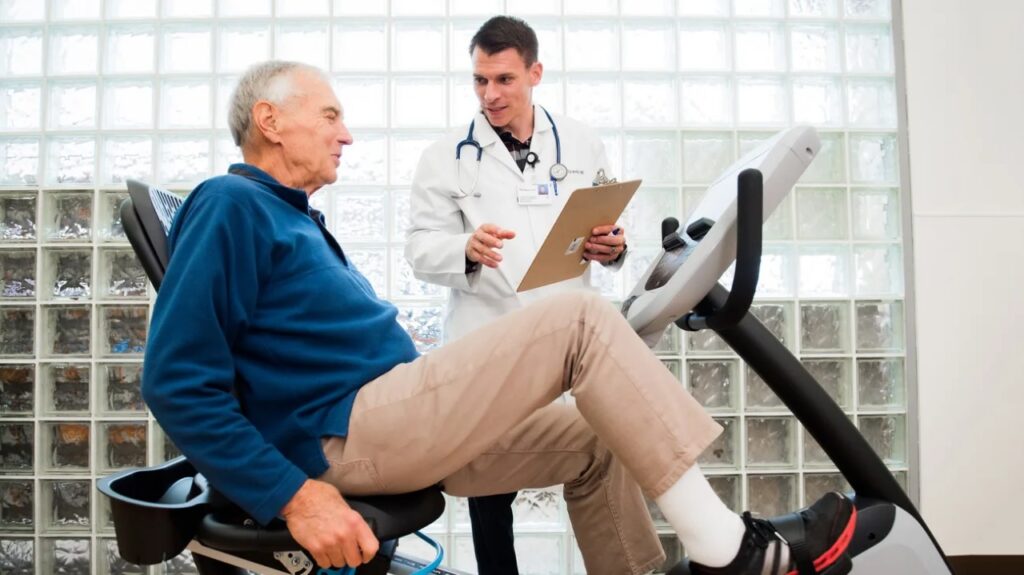
Cardiac Rehabilitation
Cardiac rehabilitation is a medically supervised program designed for patients who have undergone cardiac surgery or experienced heart-related events. Its primary goal is to enhance cardiovascular fitness, promote independence, and improve overall physical and emotional well-being through a structured, progressive exercise regimen. The program significantly boosts the heart’s endurance, helping the cardiac muscles supply sufficient oxygen to the body during physical activity. It incorporates exercises that involve multiple muscle groups, aiding in calorie burning, improving daily physical function, and making physical activity a routine part of life. With regular participation, patients gain flexibility, increased range of motion, and enhanced muscular strength and endurance. These improvements not only help patients return to daily activities but also reduce the risk of future cardiac events.Exercise components in cardiac rehabilitation include :
Aerobic/Cardiovascular Exercises : Involving large muscle groups in continuous movement, these exercises raise the heart rate and improve endurance.
Stretching : Increases flexibility and reduces injury risk.
Strength Training : Builds muscle strength and supports overall function.
Cardiac rehabilitation typically follows a three-part structure :
- Warm-up/stretching
- Cardio and strengthening exercises
- Cool-down
Conditions benefiting from cardiac rehabilitation include :
- Coronary artery disease
- Heart attack
- Heart failure
- Angina (chest pain)
- Heart valve repair or replacement
- Coronary artery bypass surgery
- Angioplasty and stent placement
- Cardiomyopathy
- Peripheral artery disease
- Pulmonary hypertension
- Heart or lung transplant recovery
Cardiac rehabilitation is effective for people of all ages and genders, offering a safe, supportive environment for recovery. Through a personalized plan, it helps restore confidence, improve quality of life, and prevent the recurrence of heart-related complications
Clinical Physiotherapy
Clinical physiotherapy is a tailored treatment approach provided by qualified physiotherapists to manage and rehabilitate musculoskeletal, neurological, cardiovascular, and other physical conditions. This patient-specific intervention is designed to prevent injuries, support recovery, and restore physical function and mobility. It is particularly beneficial for individuals recovering from surgery, injury, or pregnancy, as well as those experiencing chronic pain or functional impairments. The clinical physiotherapy process begins with a detailed assessment where the physiotherapist gathers information about the patient’s medical history, current symptoms, lifestyle, and activity
limitations. This comprehensive evaluation helps determine the underlying causes of restricted physical capacity and performance. Based on this, a customized treatment plan is created to address the individual’s specific condition, goals, and needs.
Treatment techniques used in clinical physiotherapy include manual therapy (such as massage and manipulation), therapeutic exercises, postural correction, movement retraining, and the use of specialized modalities or equipment. These methods aim to relieve pain, improve flexibility and strength, enhance mobility, and promote functional independence.
The physiotherapist also works closely with the patient’s family, caregivers, and other healthcare professionals to support a holistic and coordinated care plan. Progress is closely monitored, and the treatment program is adjusted as needed to ensure optimal recovery and to avoid aggravation of the condition.
Conditions commonly treated through clinical physiotherapy include :
Chronic Pain : Neck, back, shoulder, hip, and knee pain
Musculoskeletal Disorders : Disc herniation, spondylosis, osteoarthritis, spondylolisthesis
Neurological Issues : Stroke, carpal tunnel syndrome, peripheral neuropathies
Pediatric Conditions : Cerebral palsy, developmental delays, motor dysfunction
Geriatric Issues : Age-related musculoskeletal pain, joint stiffness, balance problems
Women’s Health Concerns : Diastasis recti, pelvic floor weakness, postnatal recovery, obesity
Vestibular Disorders : Migraines, dizziness, balance impairments
Clinical physiotherapy ensures a safe, structured, and evidence-based approach to recovery, helping patients regain control of their physical health and return to their normal daily activities with confidence and reduced risk of re-injury.
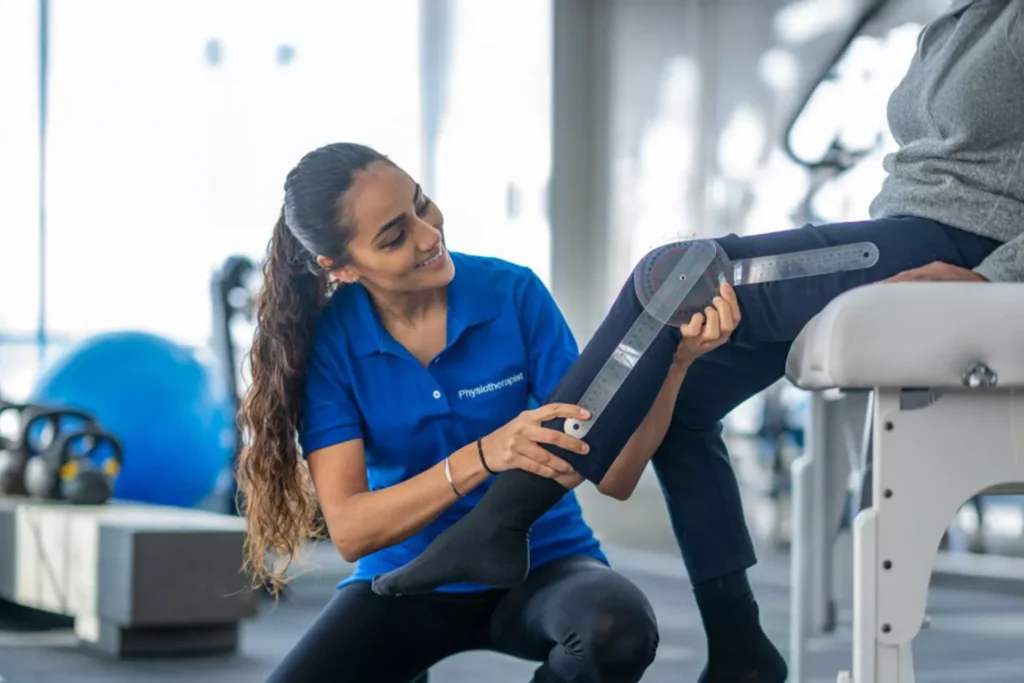
Physical Therapy
Physical therapy is a healthcare profession focused on evaluating, assessing, and treating individuals with functional limitations due to injury, illness, or disability. Licensed physical therapists are trained to help patients restore movement, reduce pain, and improve overall physical function and independence. Using a combination of treatment techniques, physical therapists address a wide range of conditions. These may include manual therapy to improve joint mobility, therapeutic exercises to build strength and flexibility, and patient education to support long-term recovery. Electrical modalities such as cryotherapy, thermotherapy, ultrasound, TENS (transcutaneous electrical nerve stimulation), laser therapy, and shockwave therapy are also commonly used to reduce pain, inflammation, and stiffness. Physical therapy plays a critical role in both rehabilitation and prevention. It is tailored to each individual’s specific needs, helping them regain the ability to move safely and efficiently.Conditions commonly treated by physical therapists include :
Musculoskeletal : Arthritis, joint stiffness, post-fracture recovery
Neurological : Stroke, spinal cord injuries, carpal tunnel syndrome
Pediatric : Torticollis, cerebral palsy, clubfoot
Geriatric : Osteoarthritis, age-related mobility issues
Sports Injuries : Sprains, ligament injuries
Women’s Health : Prenatal and postpartum pain, muscle weakness, stress incontinence
Physical therapy helps individuals lead more active, pain-free lives and promotes faster, safer recovery.
Spinal Injury Rehabilitation
Spinal cord injury (SCI) is caused by traumatic or non-traumatic events that lead to damage in the spinal cord, resulting in impaired motor, sensory, and autonomic functions. It can affect not only movement and sensation but also vital functions such as bladder and bowel control, sexual function, blood pressure regulation, respiratory ability, temperature control, and skin integrity. Rehabilitation plays a crucial role in the recovery journey, and physiotherapy is a key component in helping individuals regain as much function and independence as possible. Recovering from a spinal cord injury is often a lengthy and complex process. The degree of recovery largely depends on the level and severity of the injury—whether it is complete (no sensory or motor function below the injury site) or incomplete (some function remains). Early intervention and consistent physiotherapy are essential to optimize outcomes. Goals of spinal injury rehabilitation include : Maximizing recovery of motor and sensory functions Preventing secondary complications such as pressure sores, joint stiffness, and respiratory issues Enhancing independence in daily activities like dressing, bathing, grooming, and mobility Promoting quality of life and psychological well-being Spinal rehabilitation uses targeted exercises, assistive devices, posture and gait training, respiratory exercises, and adaptive strategies. Patients learn how to function effectively within their new capabilities and work towards living as independently as possible. Conditions that benefit from spinal rehabilitation :- Traumatic and non-traumatic spinal cord injuries
- Central nervous system or neuromuscular disorders
- Degenerative or disease-related spinal conditions
- Combined spinal cord and brain injuries
- Post-operative spinal surgery recovery
